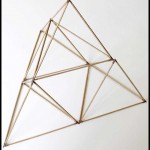After describing Alexander Graham Bell’s Sable Island kite (a version of Hargrave’s box kite) in the Drachen Foundation’s last Archive feature article, I will focus now on the tetrahedrals themselves. The DF Archive holds four early cells, without sails, from Bell’s laboratory at Beinn Bhreagh, made before he had switched to aluminum tubing for the frames in October 1903. The slender 10-inch spars are black spruce, held together with deftly designed connectors (now rusted) made from tin cans. Hector McNeil, Bell’s foreman, fabricated the connectors for Bell, and the two obtained a joint patent on them in 1907. J.H. Parkin has said, “It will be evident to those familiar with shopwork that McNeil was a wizard with tools.” The cells DF holds support this judgment, as they do Bell’s own opinion of his tetra principle—“It is astonishing how solid such a framework appears even when composed of very light and fragile material.”
 What path had Bell taken to tetrahedral construction? Curiosity had led his exploration in many directions. He had always been fascinated with flight, but witnessing Samuel Langley’s flying machine in 1891 had sparked that interest into activity. He began his flight experiments by trying to understand thrust; he constructed rocket and steam powered propellers and rotors of various designs to determine how to generate maximum thrust. Then his attention turned to the lifting properties of different airfoils or wing designs, and he had begun his kite experiments in 1896 not only to come to some understanding of lift but to study the properties of wind currents in his pursuit of manned flight.
What path had Bell taken to tetrahedral construction? Curiosity had led his exploration in many directions. He had always been fascinated with flight, but witnessing Samuel Langley’s flying machine in 1891 had sparked that interest into activity. He began his flight experiments by trying to understand thrust; he constructed rocket and steam powered propellers and rotors of various designs to determine how to generate maximum thrust. Then his attention turned to the lifting properties of different airfoils or wing designs, and he had begun his kite experiments in 1896 not only to come to some understanding of lift but to study the properties of wind currents in his pursuit of manned flight.
Bell had worked chiefly with kites based upon Australian Lawrence Hargrave’s box kite, a design that had proven its worth in meteorological flights. But by 1902, Bell was incorporating the tetrahedral cell into his kites’ designs. (A tetrahedral figure is one in which three equilateral triangles are joined to form a four sided shape.) This configuration had many inherent advantages. The kites were structurally stronger, and by combining the cells of smaller kites into one large kite, the surface area-to-weight ratio was retained. Bell’s tetrahedrals reached their apex with 1907’s Cygnet, his kite made from 3393 cells, which flew to a height of 51 meters and stayed aloft for over 7 minutes.
The tetrahedrals also proved to be very stable in flight. One of the most significant design characteristics of kite stability is dihedral: the bow, or angle of wings to one another. As is quickly seen on a tetrahedral cell, if one side of the cell is exposed to more wind than the other, it creates more lift, causing the cell to align itself to an equilibrium position in the wind.
Bell became convinced that stability was the key to manned flight: tetrahedral kites could provide that stability and permit experimentation without risk to human life. The Wrights, however, knew that a certain amount of instability was necessary and important to manned flight. As they had seen with countless beginning bicyclists, a certain amount of muscle memory and repetition would lead to stability, just as it would for the first pilots in their airplanes.

To honor the creative mind of Bell and to celebrate the 100th anniversary of the flight of the Cygnet kite, the Drachen Foundation announces the Bell Tetra Challenge. It invites all kite makers to participate in building a Bell four-cell tetrahedral kite and make it their own. The Foundation has an easy-to-assemble kit with the necessary connectors and dowels, so that your four cells will be compatible with everyone else’s.
Once constructed and flown, send us two photos of your creation, one of the kite and one which proves its flyability. A distinguished panel of judges will choose the most interesting applications of Bell’s tetra principles and award these individuals a $250. gift certificate toward purchase of kite merchandise from Goodwind’s Kites. Visit the Drachen Foundation Website for more information.
Scott Skinner

